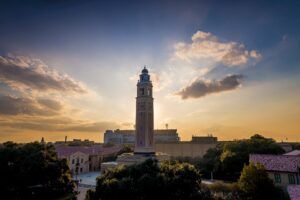The Night of the Comet
The mystery of our parents’ union: Who hasn’t felt its power? It’s the condition for our existence, the prelude to our birth. To an adolescent sorting out issues of identity, how he ended up with his parents can be both fascinating and perplexing. That’s the experience of 14-year-old Alan Broussard Jr. in George Bishop’s great new novel, The Night of the Comet. He puzzles over his parents’ improbable marriage during the year it unravels.
We learn in the prologue that the Broussard family of Terrebonne Parish is heading toward a crisis. Bishop admits, “I’d always envisioned starting the novel with a cliffhanger.” Junior, as he is called, is grown up now and living in Baton Rouge. He finds himself recalling the night in December 1973 when he watched his father climb a water tower with the apparent intention of leaping to his death. Does he do it? Why does he despair? Find out in the ensuing saga, told from “a strange kind of adult-boy point of view hybrid,” Bishop told inRegister. Junior’s voice conveys the “naiveté of youth” leavened with mature insight.
The eponymous comet that sets Junior’s story in motion is Kohoutek, predicted in 1973 to be “the comet of the century.” So says Alan Broussard Sr. to his high school students in the fictional town of Terrebonne. “You’re in for a real treat this year,” he promises at the semester’s start. “Something really special.” Alan Sr. is an Earth and Space Science teacher and a passionate amateur astronomer. In Junior’s eyes he’s awkward and wacky, a source of daily embarrassment. But as Kohoutek barrels earthward, Alan Sr. becomes a local celebrity.
Junior notes this transformation warily, seeing his dad stir up awe and anticipation in everyone—except his wife, Lydia. But the teen has his own passion to tend to: for his new neighbor Gabriella. The comet, he feels, is an agent of change. But to what end? Bishop notes, “Without getting too symbolic about it, the comet heralds Junior’s arrival into adulthood.”











